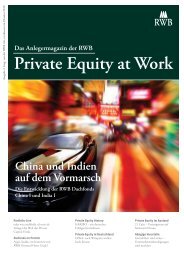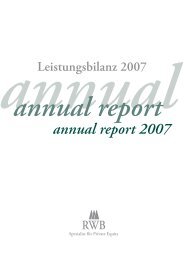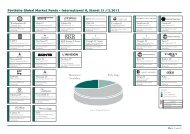Liquiditätsmanagement für Private Equity- und Venture ... - RWB AG
Liquiditätsmanagement für Private Equity- und Venture ... - RWB AG
Liquiditätsmanagement für Private Equity- und Venture ... - RWB AG
Sie wollen auch ein ePaper? Erhöhen Sie die Reichweite Ihrer Titel.
YUMPU macht aus Druck-PDFs automatisch weboptimierte ePaper, die Google liebt.
1.3 Over-Commitment 1.3 Over-Commitment<br />
In einem diversifizierten <strong>Private</strong> <strong>Equity</strong> Portfolio können<br />
Cashflow-Muster verschiedener Fondsarten innerhalb eines<br />
Portfolioansatzes genutzt werden. Buyout- <strong>und</strong> Mezzanine-<br />
Fonds nehmen Verpflichtungen üblicherweise schneller (ein<br />
bis zwei Jahre) in Anspruch als <strong>Venture</strong> Capital Fonds, welche<br />
zu einer Ausdehnung der Inanspruchnahme über vier bis<br />
fünf Jahre tendieren (siehe Maginn & Dyra (2000) zum USamerikanischen<br />
Markt). Buyout- <strong>und</strong> Mezzanine-Fonds neigen<br />
ebenso zu schnellerer Ausschüttung, da sie normalerweise<br />
über jährliche Einkommensbestandteile wie Anteile an nachrangigen<br />
Verbindlichkeiten oder Dividenden auf Vorzugsaktien<br />
verfügen. Desweiteren investieren sie in etablierte<br />
Unternehmen mit weniger verbleibenden Jahren bis zum<br />
Ausstieg.<br />
Wie dieses Beispiel zeigt, ist eine über die Zeit durchgeführte<br />
Diversifikation gr<strong>und</strong>legend <strong>für</strong> eine Over-Commitment-<br />
Strategie. Dies kann bei Investitionsprogrammen mit niedriger<br />
Laufzeit zu Problemen führen. 14<br />
Bei <strong>Private</strong> <strong>Equity</strong> <strong>und</strong> besonders im Fall von <strong>Venture</strong><br />
Capital, machen der unsichere Zeitplan <strong>für</strong> Beiträge, unbekannte<br />
Änderungen in der Bewertung der Fondsinvestitionen<br />
<strong>und</strong> unvorhersehbare Geldausschüttungen an den Limited<br />
Partner es überaus schwierig, Ereignisse vorherzubestimmen,<br />
die Liquidität erzeugen würden. Cashflows von <strong>Venture</strong><br />
Capital Fonds sind sicherlich schwer zu modellieren, es ist<br />
jedoch durchaus möglich <strong>und</strong> sogar <strong>für</strong> Investitionsprogramme<br />
in <strong>Venture</strong> Capital Fonds werden Over-<br />
Commitment-Strategien eingesetzt. 15<br />
In a diversified private equity portfolio, cash flow patterns of<br />
various f<strong>und</strong> types can be exploited within a portfolio approach.<br />
Buyout and mezzanine f<strong>und</strong>s typically draw down<br />
commitments more quickly (one to two years) than venture<br />
capital f<strong>und</strong>s that tend to stretch draw downs over four to five<br />
years (see Maginn & Dyra (2000) about the US market).<br />
Buyout and mezzanine f<strong>und</strong>s also tend to distribute more<br />
quickly, as they usually have annual income components such<br />
as interest on subordinated debt or dividends on preferred<br />
stock. They also invest in established companies with fewer<br />
years to exit.<br />
As this example shows, diversification over time is essential<br />
for an over-commitment strategy. For investment programmes<br />
that only have a short lifetime, this can become problematic. 14<br />
For private equity, and especially in the case of venture capital,<br />
the uncertain schedule of contributions, unknown changes in<br />
the valuation of f<strong>und</strong> investments and unpredictable distributions<br />
of cash to the limited partner make it very difficult to<br />
predict events that would generate liquidity. Cash flows of<br />
venture capital f<strong>und</strong>s are certainly hard to model, but they can<br />
be modelled, and even for venture capital f<strong>und</strong> investment<br />
programmes over-commitment strategies are in operation. 15<br />
14 Siehe Steers (2002): Institutionelle Investoren haben entdeckt, dass sie ganze 30% bis 40% mehr als ihre<br />
14 See Steers (2002): Institutional investors have discovered that they need to commit as much as 30% to 40% more<br />
42 43<br />
Regelallokation in <strong>Private</strong> <strong>Equity</strong> investieren müssen, um das vorgesehene Kapital renditeträchtig anzulegen. Dem<br />
Autor zufolge nutzten kontinentale Investoren im Jahr 2001 etwa 40% ihrer strategischen Allokation als Over-<br />
Commitment in dem Versuch, mehr Kapital tatsächlich anlegen zu können. Investoren in Großbritannien verfügten<br />
über ein Over-Commitment-Level von 16%.<br />
15 Siehe Real Deals (2004): Mowbray Capital beabsichtigte, 100 Mio. € <strong>und</strong> 300 Mio. € überwiegend in <strong>Venture</strong><br />
Capital Fonds im Frühstadium zu investieren <strong>und</strong> gleichzeitig eine Over-Commitment-Strategie zu verfolgen.<br />
than their policy allocation to private equity in order to get capital working. According to the author in 2001<br />
continental investors had over-committed aro<strong>und</strong> 40% of their strategic allocation in an attempt to get more<br />
capital actually invested; UK investors had an over-commitment level of 16%.<br />
15 See Real Deals (2004): Mowbray Capital aimed to invest EUR 100m and EUR 300m pre-dominantly in early<br />
stage venture capital f<strong>und</strong>s while running an over-commitment strategy.







